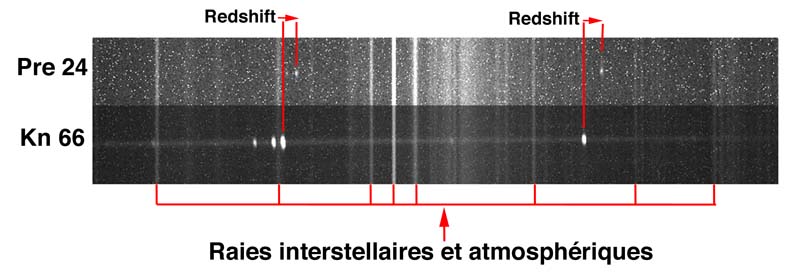Page 1 of 2
Publication about 4 new galaxies
Posted: Thu Oct 03, 2019 6:43 am
by Olivier GARDE
With some friends of PNST group and our PN confirmation work :
http://planetarynebulae.net/EN/
We have found 4 newly galaxies.
Here's the publication :
https://arxiv.org/abs/1906.09612
Many thanks to Dr Michael Koenig who help us writing this article.
Re: Publication about 4 new galaxies
Posted: Thu Oct 03, 2019 8:22 am
by Hamish Barker
nice work.
When I saw the spectrum of Pre21 I thought it would be a planetary nebula because the emission lines are so prominent. Is the doppler measurement (wavelength calibration) is the decisive factor?
Re: Publication about 4 new galaxies
Posted: Fri Oct 04, 2019 6:40 pm
by Forrest Sims
Olivier,
Congratulations to you and the French amateur team on some very fine work.
Also very nice to see further capabilities of the Shelyak LISA. No limits right

Now where did I put my 1 meter telescope....?
Woody Sims
Re: Publication about 4 new galaxies
Posted: Fri Oct 04, 2019 6:59 pm
by Francois Teyssier
Félicitations!
Un superbe travail de l'équipe NP
Bonne continuation,
François
Re: Publication about 4 new galaxies
Posted: Sat Oct 05, 2019 7:16 am
by Olivier GARDE
Hamish Barker wrote:nice work.
Is the doppler measurement (wavelength calibration) is the decisive factor?
Yes Hamish,
We saw very well on the raw images that the lines were not in the right place and all shifted towards the red, so not an object from our galaxy.

This is an example with Pre24 compare with another PN KN66 (who is a real PN)
And with the values of each emission line, it's easy to calculate the redshift z.
Re: Publication about 4 new galaxies
Posted: Sun Oct 06, 2019 4:51 pm
by Benjamin Mauclaire
Hello,
Is the paper all ready published in MNRAS?
Can we open Champagne bootle?

I was suprised by the amout of decimal numbers available for Z computation.
How uncertainties for Z and DeltaLambda were computed? They should appear in tables too.
So I looked at DeltaLambda which accuracy is 1/10 A.
It seems rather impossible to get such accuracy with R500 spectrograph.
Resolution element for this setup around Ha is:
RE=6563/500=13.13 A~2 pixels
RE is the smallest difference in wavelengths that can be distinguished at a wavelength (here Ha: 6563 A).
So 1 pixel depicts about 6.6 A. How can measurements lead to 1/10 A accuracy?
Computed velocities at Ha line from Delta_z=0.0016 leads to 48 km/s whereas RE leads to ~600 km/s, ie 1 pixel depitcs ~300 km/s.
In tables Flux are reported but plots are scaled in Relative flux. What is the accuracy of these measurements?
When I wanted to know more about theses objects discoverers, I found no bibliographics references in the text.
Introduction let the reader thinking there are no other red shifted H II surveys all ready done.
This paper is perhaps a first in this field by amateurs but unfortunately it undermines the work that can be provided by the amateur community.
Friendly,
Benji
Re: Publication about 4 new galaxies
Posted: Sun Oct 06, 2019 10:30 pm
by Robin Leadbeater
Hi Benji,
I agree the quoted accuracy and precision for z does seem very high. (I suspect the quoted precision of 0.1A is the calibration fit error, not the measurement uncertainty in the wavelength of the lines in the target)
David Boyd demonstrated that with good technique, the LISA is capable of 5.2km/s RMS precision on a bright target
https://www.britastro.org/downloads/15701
"Observing with a LISA spectrograph - David Boyd"
But that was using cross correlation on G stars and would be difficult to achieve on such faint targets and fewer lines. Also absolute accuracy as needed here would need measurements of an a RV standard.
It is still an impressive achievement but if I were the referee I would want to know more about the precision/accuracy of the z results
EDIT: I see the errors in z based on the residuals in the lines measured are included but one less decimal point quoted precision and an estimate of the absolute error would be better
Cheers
Robin
Re: Publication about 4 new galaxies
Posted: Mon Oct 07, 2019 12:23 am
by etienne bertrand
C'est quand même bien classe c'est article ! Bravo.
Il faudrait que je m'y mette à ces classement de nébuleuses ça à l'air bien sympa de partir à leur recherche.
Re: Publication about 4 new galaxies
Posted: Mon Oct 07, 2019 7:30 am
by Benjamin Mauclaire
Robin,
David worked with a temperature stabilized Lisa with narrow slit where RV were measured from a CCF.
In Oliver and al. paper they used a 50 um slit leading to R500.
There are no comparison to do with David's work.
Benji
Re: Publication about 4 new galaxies
Posted: Mon Oct 07, 2019 12:30 pm
by Robin Leadbeater
Benjamin Mauclaire wrote:Robin,
David worked with a temperature stabilized Lisa with narrow slit where RV were measured from a CCF.
In Oliver and al. paper they used a 50 um slit leading to R500.
There are no comparison to do with David's work.
Benji
Hi Benji,
Yes I agree. I made this clear in my post. I agree with you that the quoted absolute accuracy in the paper is not supported by evidence presented there.
Cheers
Robin
